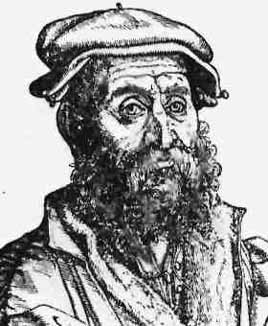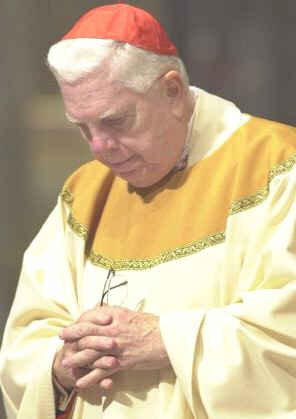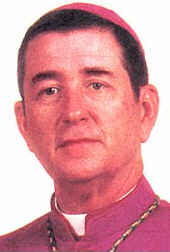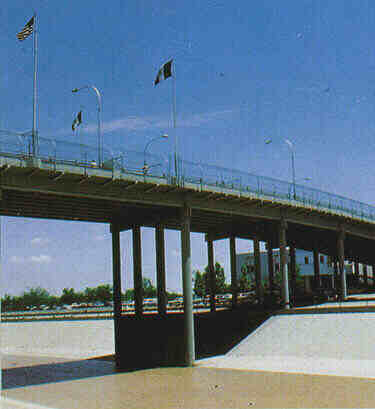 1557
Niccolò
Fontana "Tartaglia", 58, Italian mathematician. 1557
Niccolò
Fontana "Tartaglia", 58, Italian mathematician.
[The poem in which he revealed the secret of solving the cubic to Cardan]
When the cube and the things together
Are equal to some discrete number, (1)
Find two other numbers differing in this one.
Then you will keep this as a habit
That their product shall always be equal
Exactly to the cube of a third of the things. (2)
The remainder then as a general rule
Of their cube roots subtracted
Will be equal to your principal thing. (3) (1)
[Solve x^3 + cx = d]
(2) [Find u, v such that u - v = d and uv = (c/3)^3 ]
(3) [Then x = u^(1/3) - v^(1/3) ]
Niccolò Fontana known as Tartaglia,
was born in Brescia in 1499, the son of a humble mail rider. He was nearly
killed as a teenager, when in 1512 the French captured his home town and
put it to the sword. Amidst the general slaughter, the twelve year old
boy was dealt horrific facial sabre wounds that cut his jaw and palate
and he was left for dead. His mother's tender care ensured that the youngster
did survive, but in later life Niccolò always wore a beard to camouflage
his disfiguring scars and he could only speak with difficulty, hence his
nickname Tartaglia, or stammerer.
Tartaglia was self taught in mathematics
but, having an extraordinary ability, was able to earn his living teaching
at Verona and Venice. As a lowly mathematics teacher in Venice, Tartaglia
gradually acquired a reputation as a promising mathematician by participating
successfully in a large number of debates.
The first person known to have solved cubic
equations algebraically
was del Ferro but he told nobody of his achievement. On his deathbed,
however, del Ferro passed on the secret to his (rather poor) student Fior.
Fior began to boast that he was able to solve cubics
and a challenge between him and Tartaglia was arranged in 1535. Each man
was to submit thirty questions for the other to complete. Fior was supremely
confident that his ability to solve cubics
would be enough to defeat Tartaglia but because negative numbers were
not used there was more than one type of cubic
equation and Fior had only been shown by del
Ferro how to solve one type. Tartaglia submitted a variety of different
questions, exposing Fior as an, at best, mediocre mathematician. Fior,
on the other hand, offered Tartaglia thirty opportunities to solve the
cosa
and cube problem since he believed that he would be unable to solve this
type. However, in the early hours of 13 February 1535, inspiration came
to Tartaglia and he discovered the method to solve both types of cubic.
Tartaglia now knowing the method to solve the cosa
and cube problems, quickly solved all thirty of Fior's problems in less
than two hours. As Fior had made little headway with Tartaglia's questions,
it was obvious to all who the winner was.
At this point that Cardan enters the story. As public lecturer of
mathematics at the Piatti Foundation in Milan, he was aware of the cosa
and cube problems, but, until the contest, he had taken Pacioli at his word and assumed as Pacioli stated
in the Suma published in 1494, that solutions were impossible.
Cardan was greatly intrigued when he learned of the contest and immediately
set to work on trying to discover Tartaglia's method for himself, but
was unsuccessful. A few years later, in 1539 he contacted Tartaglia, through
an intermediary, requesting that the method could be included in a book
he was publishing that year. Tartaglia declined this opportunity, stating
his intention to publish his formula in a book of his own that he was
going to write at a later date. Cardan , accepting this, then asked to
be shown the method, promising, if he was, to keep it secret. Tartaglia,
however, refused.
An incensed Cardan now wrote to Tartaglia
directly, expressing his bitterness, challenging him to a debate but,
at the same time, hinting that he had been discussing Tartaglia's brilliance
with the governor of the emperor's army in Milan, Alfonso d'Avalos, the
Marchese del Vasto, who one of Cardan's powerful sponsors. On receipt
of this letter, Tartaglia radically revised his attitude, realizing that
acquaintance with the influential Milanese governor could be very rewarding
and could provide a way out of the modest teacher's job he then held,
and into a lucrative job at the Milanese court. He wrote back to Cardan
in friendly terms, angling for an introduction to the Signor Marchese.
Cardan was delighted at Tartaglia's new approach, and, inviting him to
his house, assured Tartaglia that he would arrange a meeting with d'Avalos.
So, in March 1539, Tartaglia left Venice
and travelled to Milan. To Tartaglia's dismay, the governor was temporarily
absent from Milan but Cardan attended to his guest's every need and soon
the conversation turned the cosa
and cube problem. Tartaglia, after much persuasion, agreed to tell Cardan
his method, if the Cardan would swear never to reveal it and furthermore,
to only ever write it down in code so that on his death, nobody would
discover the secret from his papers. This Cardan readily agreed to, and
Tartaglia divulged his formula in a poem, to help protect the secret,
should the paper fall into the wrong hands. Anxious now to leave Cardan
's house, he obtained from his host, a letter of introduction to the Marchese
and left to seek him out. Instead though, he turned back for Venice, wondering
if his decision to part with his formula had been a mistake.
By the time he reached Venice, Tartaglia
was sure he had made a mistake in trusting Cardan and began to feel very
angry that he had been induced to reveal his secret formula. Cardan published
two mathematical books that year and, as soon as he could get copies,
Tartaglia checked to make sure his formula was not included. Though he
felt a little happier to find that the formula was not included in the
texts, when Cardan wrote to him in a friendly manner Tartaglia rebuffed
his offer of continued friendship and mercilessly ridiculed his books
on the merest trivialities.
Based on Tartaglia's formula, Cardan and
Ferrari,
his assistant, made remarkable progress finding proofs of all cases of
the cubic
and, even more impressively, solving the quartic
equation. Tartaglia made no move to publish his formula, despite
the fact that, by now, it had become well known that such a method existed.
Tartaglia probably wished to keep his formula in reserve for any upcoming
debates.
Cardan and Ferrari travelled to Bologna
and learnt from della Nave that del Ferro and not Tartaglia had been the
first to solve the cubic
equation. Cardan felt that although he had sworn not to reveal
Tartaglia's method surely nothing prevented him from publishing del Ferro's
formula. In 1545 Cardan published Artis magnae sive de regulis algebraicis
liber unus or Ars magna as it is more commonly known which
contained solutions to the cubic
and quartic
equations and all of the additional work he had completed on
Tartaglia's formula. Del Ferro and Tartaglia are fully credited with their
discoveries, as is Ferrari, and the whole story written down in the text.
Tartaglia was furious when he discovered
that Cardan had disregarded his oath and his intense dislike of Cardan
turned into a pathological hatred. The following year Tartaglia published
a book, New Problems and Inventions which clearly stated his
side of the story and his belief that Cardan had acted in extreme bad
faith. For good measure, he added a few malicious personal insults directed
against Cardan .
Ars Magna had clearly established
Cardan as the world's leading mathematician and he was not much damaged
by Tartaglia's venomous attacks. Ferrari, however, wrote to Tartaglia,
berating him mercilessly and challenged him to a public debate. Tartaglia
was extremely reluctant to dispute with Ferrari, still a relatively unknown
mathematician, against whom even a victory would do little material good.
A debate with Cardan , on the other hand, held great appeal for Tartaglia.
Not only did he hate him but Cardan was a leading figure in the mathematical,
medical and literary worlds, and even to enter a debate with him would
greatly enhance Tartaglia's standing. For all the brilliance of his discovery
of the solution to the cosa
and cube problem, Tartaglia was still a relatively poor mathematics teacher
in Venice.
So Tartaglia replied to Ferrari, trying
to bring Cardan into the debate. Cardan , however, had no intention of
debating with Tartaglia. Ferrari and Tartaglia wrote fruitlessly to each
other for about a year, trading the most offensive personal insults but
achieving little in the way of resolving the dispute. Suddenly in 1548,
Tartaglia received an impressive offer of a lectureship in his home town,
Brescia. To clearly establish his credential for the post, Tartaglia was
asked to journey to Milan and take part in the contest with Ferrari.
On 10 August 1548 the contest took place
in the Church in the Garden of the Frati Zoccolanti. Tartaglia was vastly
experienced in such debates and expected to win. However, by the end of
the first day, it was clear that things were not going Tartaglia's way.
Ferrari clearly understood the cubic
and quartic
equations more thoroughly and Tartaglia decided that he would
leave Milan that night and thus leave the contest unresolved. With Tartaglia
departing ignominiously, victory was left to Ferrari.
Tartaglia suffered as a result of the contest.
After giving his lectures for a year in Brescia, he was informed that
his stipend was not going to honored. Even after numerous lawsuits, Tartaglia
could not get any payment and returned, seriously out of pocket, to his
previous job in Venice, nursing a huge resentment of Cardan . The defeat
in Milan would appear to be responsible for Tartaglia's non-payment.
Tartaglia is now remembered in that the
name of the formula for solving the cubic
has been named the Cardan -Tartaglia formula. However, Tartaglia did contribute
to mathematics in a number of other ways. Fairly early in his career,
before he became involved in the arguments about the cubic
equation, he wrote Nova Scientia (1537) on the application
of mathematics to artillery fire. In the work he described new ballistic
methods and instruments, including the first firing tables.
Tartaglia also wrote a popular arithmetic
text and was the first Italian translator and publisher of Euclid's Elements in 1543. In 1546 he
published Quesiti et Inventioni diverse de Nicolo Tartalea referred
to above. He also published Latin editions of Archimedes's works. |
 On
a December 13:
On
a December 13:  The
pope names Boston auxiliary bishop Richard G. Lennon, 55 [< photo],
as temporary administrator of the archdiocese. Bernard Francis Law was born
in Torreón, Mexico, on 04 November 1931. Ordained a priest on 21
May 1961, he was appointed Bishop of Springfield-Cape Girardeau, Missouri,
on 22 October 1973, and Archbishop of Boston on 23 March 1984. He was named
a cardinal on 25 May 1985.
The
pope names Boston auxiliary bishop Richard G. Lennon, 55 [< photo],
as temporary administrator of the archdiocese. Bernard Francis Law was born
in Torreón, Mexico, on 04 November 1931. Ordained a priest on 21
May 1961, he was appointed Bishop of Springfield-Cape Girardeau, Missouri,
on 22 October 1973, and Archbishop of Boston on 23 March 1984. He was named
a cardinal on 25 May 1985.  Chamizal Boundary Settlement Project
Chamizal Boundary Settlement Project  1950
1950
 1557
1557